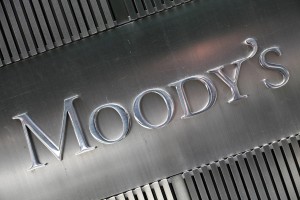Moody’s lifts US outlook to ‘stable’ from ‘negative’

This Aug. 13, 2010 photo shows a sign for Moody’s Corp. in New York. Moody’s Investors Service upgraded the outlook for US government debt to “stable” from “negative” on Thursday, July 18, 2013. The rating agency cited a surprising drop in the federal deficit – the difference between what the government collects in taxes and what it spends. AP Photo/Mark Lennihan
WASHINGTON—Ratings firm Moody’s raised its outlook on the United States on Thursday to “stable” from “negative,” citing the federal government’s progress in putting debt on a more sustainable path.
Moody’s “today moved the outlook on the Aaa government bond rating of the United States back to stable, replacing the negative outlook that has been in place since August 2011,” the company said in a statement.
Moody’s also pointed out the top triple-A rating was still warranted on US sovereign debt.
Moody’s said the outlook upgrade reflected its view “that the federal government’s debt trajectory is on track to meet the criteria laid out in August 2011 for a return to a stable outlook.”
The improvement removed the downward pressure on the rating, it said.
“The US budget deficits have been declining and are expected to continue to decline over the next few years.
“Furthermore, the growth of the US economy, which, while moderate, is currently progressing at a faster rate compared with several Aaa peers and has demonstrated a degree of resilience to major reductions in the growth of government spending,” the company said.
For those reasons, Moody’s said, the US government’s ratio of debt to gross domestic product (GDP) will fall more sharply through 2018 than the company had estimated when it downgraded the outlook nearly two years ago.
More budget tightening needed
But Moody’s warned that the government needs to step up its budget tightening to prevent the buildup of unhealthy debt pressures in the longer term.
“Despite the more favorable fiscal outlook over the next several years, without further fiscal consolidation efforts, government deficits are anticipated to increase once again over the longer term.”
Such an outcome could once again weigh on the US triple-A rating but at this point appears unlikely, it said.
Moody’s said the outlook upgrade came after the Congressional Budget Office (CBO) projected the budget deficit for the 2013 fiscal year that ends on September 30 would fall to 4.0 percent of GDP from 7.0 percent in 2012.
The steep decline was sharper than Moody’s had estimated in 2011, it said, and was being driven by sharp spending cuts, known as sequestration; tax increases; and a slowdown in federal health care spending.
“Even without any further policy measures, the CBO expects the deficit to fall further to 3.4 percent in fiscal 2014 and 2.1 percent in 2015, and to remain below 3.0 percent for the following four years,” Moody’s pointed out.
By comparison, the deficit hit a peak of 10.1 percent of GDP in 2009 as the government fought to pull the economy out of the Great Recession.